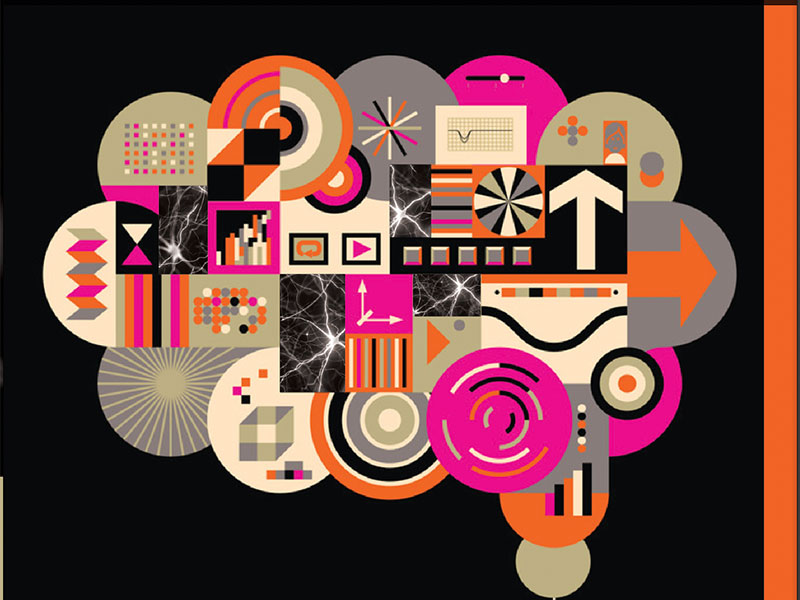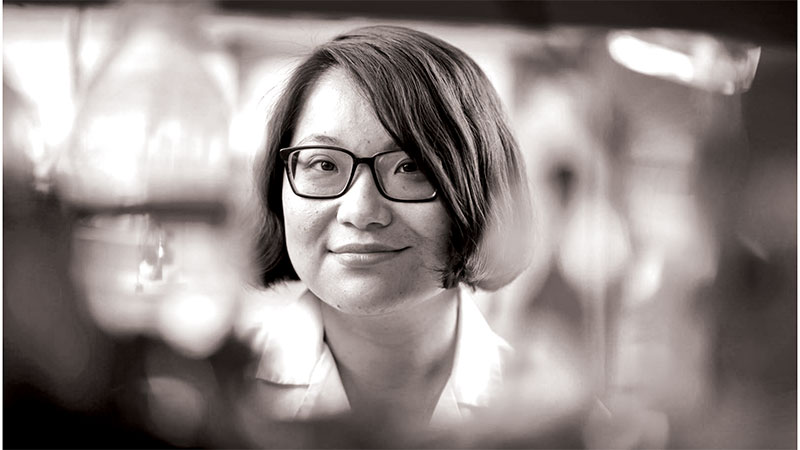
If you ask Scripps Research assistant professor Xin Jin how she would describe the brain, she’ll tell you it’s like a village.
It may have different citizens who speak diverse languages, but everyone in the community must work together for it to function. And when things do become dysfunctional, it’s important to understand who—and when and where—in the village needs help.
If Jin’s name sounds familiar, it may be because her pioneering neuroscience research has won countless awards recently, including being named to the prestigious MIT Technology Review’s ‘35 Innovators Under 35’ 2022 list. She’s one of the first in her field to build a new set of tools that illuminates the mechanisms involved in different mental disorders, notably during the brain’s development. A chemist-turned-neurobiologist, Jin is fascinated by these inner workings of the mind, and she’s determined to bring them to light.
Scripps Research Magazine sat down with Jin to learn more about her work, the obstacles to studying neuroscience, and her quest to unravel how complex and interconnected the village of the brain is.

Was there a moment that first inspired you to pursue a career in science?
My grandfather was a botanist, and I would spend time with him in the plant biology lab he worked at in China. And I remember it as such a romantic job—him walking around in a garden with a little notebook. He drew such beautiful illustrations of all these types of plants and their differences. I found it so interesting to behold how different individual plants evolve over time, given their unique dynamics.
I clearly remember him telling me how there can be two extremely similar looking plants, except one of them is toxic. Although they look very, very similar, if you pay attention, the leaf shape is slightly different. At that moment, he was telling me to pay attention to the morphology. It’s one thing to describe, record and interpret biology, but you also need to understand composition and function.
This is what, in part, inspired me to pursue chemistry in my early career. I wanted to know the compounds that endowed the world with all these functions—understanding beyond just what we can physically see and portray.
After studying chemistry in your undergraduate days, what drew you to the biology side?
While studying chemistry at MIT, I became more exposed to chemical biology, and I found it extremely fascinating how the science was no longer just about a particular compound but about complex systems. While I still realize that evaluating chemical composition to determine the function of a molecule is one way of doing research, I started to see there is a bigger forest out there—one where everything is part of a larger circuit. In my graduate studies, I had the fortune to work in several labs (including the amazing lab of Ben Cravatt here at Scripps Research) and knew I wanted to use my chemical biology mindset to and a biological problem and solve it.
Was there something that eventually led you to focus on neuroscience?
When I met my PhD advisor at Rockefeller University, Cori Bargmann, she had worked on this very compact nervous system of the C. elegans—a type of roundworm—that has only 302 neurons. This just blew my mind. I didn’t know there was an organism that precise, reproducible and tractable. Every single one of its neurons even has a name because we know so much about them. That was very satisfying to me from a chemistry perspective.
I thought at the time, “This is such a simple nervous system.” Five years later, I no longer call this system simple. Now I always call them compact because after years of studying the brains of C. elegans you realize they’re not simple, despite their number of neurons. We still have so many questions to answer about how a brain like that works.
What are you working on here at Scripps Research?
While I’m no longer studying roundworms, I joined Scripps Research to answer some of these fundamental questions in neuroscience. I’m now working on building and applying genetic and genomic tools to decode the brain. Over the last two decades, we’ve been seeing growing evidence of the genetic basis of neuropsychiatric disorders and diseases, including autism spectrum disorders, schizophrenia, bipolar disorders, and so on. With this information, the field has been able to use large-scale, high-resolution, genome-wide approaches and identify the particular genetic variants and genetic loci that are associated with the disease manifestation.
In my lab, we’re working on decoding the particular brain regions, cell types and molecular pathways altered in these diseases and disorders. This is something we call ‘functional genomics.’ It’s not about just identifying the genetic sequence, but understanding, annotating and eventually translating the biology with this information. Eventually, this approach could help the field design a future therapy that could potentially halt or reverse disease pathology.
Why has “decoding” the brain been so difficult for scientists to accomplish in the past?
For a long time, biologists have had to decide between two things: scale and depth. Very often, we could understand everything about a single gene, including the structure, the function, how it works. But typically, you can only afford to do this with one or maybe a few genes—not in a very scalable way. On the other hand, we can now investigate every single gene in our entire genome simultaneously, but most of these large-scale experiments lack depth and are unable to explore how genes are changing the subtleties of a cell or across different cell types.
Why do scale and depth matter for studying the brain in particular?
We have hundreds of risk genes implicated in neurological developmental disorders such as autism and schizophrenia. These different genetic variants are obviously not doing just one thing, because if that’s true, the field perhaps would’ve found that out already. However, it’s also likely they are probably also not doing hundreds of individual different things—otherwise, there would be a well-defined pathological manifestation for what we call autism, schizophrenia, and so forth. So, the number of genes implicated is between one and thousands. The question is whether it’s possible that some subsets of these genetic variants are required for a specific time window and a specific cell type in brain development.
With both depth and scale, we could grasp how different genetic variants alter different cell types at certain times of development. This would really help us stratify these different disorders and populations, genetically define their subtypes and eventually understand the function of the variants.
How are you overcoming these challenges in the neuroscience field?
I’m a chemist turned neurobiologist. So, in my head, I always want to build new tools that push forward our resolution and our scale.
It’s like Galileo without a microscope. In the neuroscience field, it became clear to me that we needed to build a better ‘microscope’ to start beholding the brain’s many mechanisms and how they impact different diseases. In my lab, we are building this new tool, thanks to CRISPR and emerging single-cell technologies, to gain both scale and depth in our experiments. The field is at an inflection point where many of these technologies were not routine practice even just five years ago, but they will be five years from now. The current tipping point is that these things are still not that easy, but they are now tangible. And that’s where my lab and I are very excited about contributing.
“Over the last two decades, we’ve been seeing growing evidence of the genetic basis of neuropsychiatric disorders and diseases, including autism spectrum disorders, schizophrenia, bipolar disorders, and so on.”
What are these new technologies you’re building capable of?
I like to borrow this metaphor from a colleague—that our brain is like a fruit salad. You have 20 pieces of apple, five slices of an orange, maybe some pineapple. Beforehand, we would have to take out a sample of tissue, blend it and then analyze the mixture using genomics and proteomics. The problem with this approach is that it basically creates a smoothie out of the sample, and it becomes really hard to figure out the different fruits inside of it. When you look at the full fruit salad, on the other hand, you can easily select and compare what it’s made of.
With our new tools, we are hoping to compare apple to apple, orange to orange—analyzing one single cell at a time to be able to determine the differences between the brain’s diseased states and non-diseased states.
Specifically, our team is building approaches that translate the linear sequences in our genome—think A, G, C and T—into high-dimensional, high-functional annotations. What time are these genetic variations occurring at in terms of development? Where in the anatomy? What’s happening inside the cell? What cell type? We’re trying to make these connections that will hopefully collectively allow us to have a more comprehensive and unifying understanding of the brain function as a whole.
When you’re not in the lab, what else interests you?
Since moving to California from the East Coast, I became a big plant person. It’s a training process, I must admit. I’m also trying to do more outdoor exercise. I assembled a small swimming team here—our department faculty go out and swim together as a sort of informal faculty meeting. I must admit that I always feel a little bit inadequate swimming with these local Californians; they are so fast! So, I assembled another swimming team myself with a few other fellow transplants, including friends from the chemistry department, that I sometimes jokingly refer to as the ‘B team.’
What led you to Scripps Research?
When I was studying chemistry during my undergraduate days, I came to the Ben Cravatt lab here at Scripps Research for a summer internship. It was one of the best summers I’ve had, and that’s why being here as an assistant professor feels like homecoming a little bit.
Scripps Research is unique in its ability to build interdisciplinary approaches. I talk a lot with the chemistry, molecular medicine and immunology folks, in addition to my colleagues and friends here in neuroscience. These cross-disciplinary conversations really inspire us to invent more innovative approaches, and even help us identify questions that we didn’t think about in a monolithic culture and training. We all know that diversity is important for any culture or community. I’ll always have a little bit of a chemist in me, and I enjoy building, adapting and applying new tools to solve biological problems. Scripps Research has an open and diverse culture that can foster this kind of science and enable its impact.